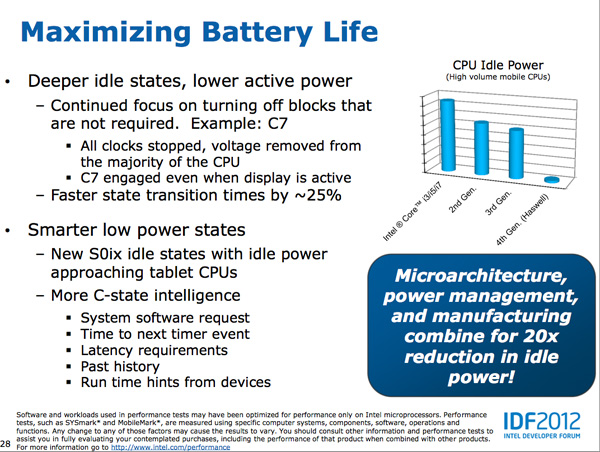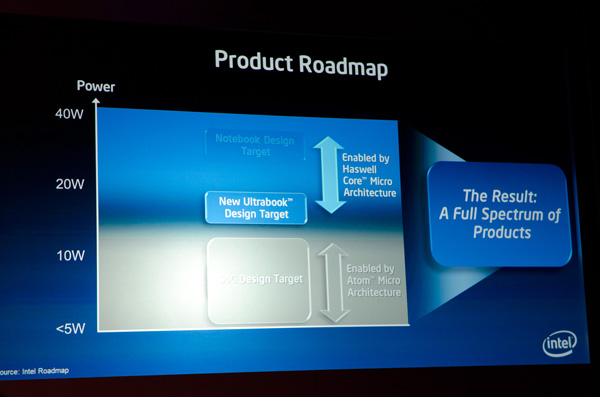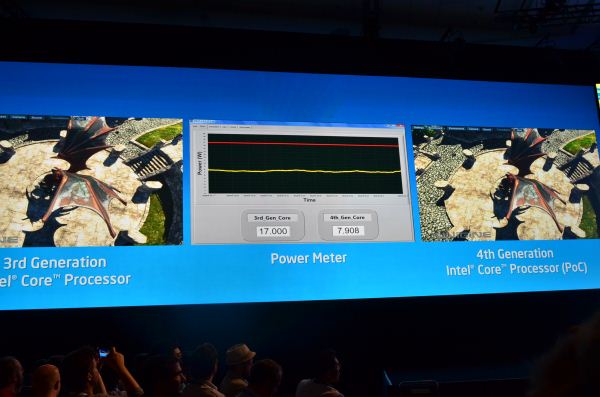Intel's Haswell Architecture Analyzed: Building a New PC and a New Intel
by Anand Lal Shimpi on October 5, 2012 2:45 AM ESTOther Power Savings
Haswell's power savings come from three sources, all of which are equally important. We already went over the most unique: Intel's focus on reducing total platform power consumption by paying attention to everything else on the motherboard (third party controllers, voltage regulation, etc...). The other two sources of power savings are more traditional, but still very significant.

At the micro-architecture level Intel added more power gating and low power modes to Haswell. The additional power gating gives the power control unit (PCU) more fine grained control over shutting off parts of the core that aren't used. Intel published a relatively meaningless graph showing idle power for standard voltage mobile Haswell compared to the previous three generations of Core processors.
Haswell can also transition between power states approximately 25% faster than Ivy Bridge, which lets the PCU be a bit more aggressive in which power state it selects since the penalty of coming out of it is appreciably lower. It's important to put the timing of all of this in perspective. Putting the CPU cores to sleep and removing voltage/power from them even for a matter of milliseconds adds up to the sort of savings necessary to really enable the sort of always-on, always-connected behavior Haswell based systems are expected to deliver.
Intel has also done a lot of work at the process level to bring Haswell's power consumption down. As a tock, Haswell is the second micro-architecture to use Intel's new 22nm tri-gate transistors. The learnings from Ivy Bridge are thus all poured into Haswell. Intel wasn't too specific on what it did on the manufacturing side to help drive power down in Haswell other than to say that a non-insignificant amount of work came from the fabs.
The Fourth Haswell
At Computex Intel's Mooly Eden showed off this slide that positioned Haswell as a 15-20W part, while Atom based SoCs would scale up to 10W and perhaps beyond:
Just before this year's IDF Intel claimed that Haswell ULT would start at 10W, down from 17W in Sandy/Ivy Bridge. Finally, at IDF Intel showed a demo of Haswell running the Unigen Heaven benchmark at under 8W:
The chain of events tells us two things: 1) Intel likes to play its cards close to its chest, and 2) the sub-10W space won't be serviced by Atom exclusively.
Intel said Haswell can scale below 10W, but it didn't provide a lower bound. It's too much to assume Haswell would go into a phone, but once you get to the 8W point and look south you open yourself up to fitting into things the size of a third generation iPad. Move to 14nm, 10nm and beyond then it becomes more feasible that you could fit this class of architecture into something even more portable.
Intel is being very tight lipped about the fourth client Haswell (remember the first three were desktop, mobile and ultra-low-volt/Ultrabook) but it's clear that it has real aspirations to use it in a space traditionally reserved for ARM or Atom SoCs.
One of the first things I ever heard about Haswell was that it was Intel's solution to the ARM problem. I don't believe a 10W notebook is going to do anything to the ARM problem, but a sub-8W Haswell in an iPad 3 form factor could be very compelling. Haswell won't be fanless, but Broadwell (14nm) could be. And that could be a real solution to the ARM problem, at least outside of a phone.
As I said before, I don't see Haswell making it into a phone but that's not to say a future derivative on a lower power process wouldn't.













245 Comments
View All Comments
Magik_Breezy - Sunday, October 14, 2012 - link
Probably real customer support without paying an extra $200Spunjji - Thursday, October 18, 2012 - link
Yawn.Spunjji - Thursday, October 18, 2012 - link
The bit that aggravates me the most is that even with this lavishing of review pages, the actual comparison of Apple products to competitors tends to lack (particularly with the Macbook article). This is understandable under some circumstances (iPhone battery life - new test, small selection of data points) but not for others.Arbee - Friday, October 5, 2012 - link
I'm not really seeing any of that. AT's Android and Windows Phone reviews are just as in-depth and complementary where due as their Apple ones. AFAIK both Anand's and Brian's daily-driver phones aren't iPhones, even. They care about the tech, not who it comes from. It just happens that Apple is often the original source of new and interesting things in that space. At this exact moment they're the only people shipping something new and interesting. When the Nokia 920 launches, I'm confident Anand and Brian will be ready with a 15+ page review and discussion of anything novel on the podcast, and when Winter CES brings us Tegra 4 and other Android news, I expect to see eye-glazing levels of detail here at AT.(As an aside, I smiled at how closely DPReview's discussion of the alleged "purple haze" problem tracked Brian's rant on the podcast - clearly both writers know what they're talking about, which can be a rare quantity in tech journalism).
VivekGowri - Saturday, October 6, 2012 - link
I think Anand's daily driver is an iPhone, but he frequently carries the latest Android/WP device on the side. Brian and myself end up daily driving like a half dozen phones a month, depending on what shows up at our doorstep.Zink - Saturday, October 6, 2012 - link
"iPad 3 form factor" was used because all of the other tablets have 25Wh batteries and draw about 5W max. The A5X iPad and it's giant 42.5Wh battery on the other hand can put out over 10W of heat which is the power envelope where Intel might target a Haswell SOC.amdwilliam1985 - Monday, October 8, 2012 - link
I totally agree with you on the Apple part. That's the biggest pullback on reading Anand writings. Too much Apple praising.I used to be an Apple fan, but recently they're becoming the biggest jerks in the technology industry. The human/ethical part of in me hates them so much, that I won't buy anything that has a Apple logo on it.
I gave away my iPad 2, switched to Samsung Galaxy S phones, and using my HP windows 7 laptop over the 2011 MBA.
-say NO to bully, say NO to Apple.
xaml - Thursday, May 23, 2013 - link
Number of problems solved with this approach: NO.dartox - Tuesday, November 27, 2012 - link
Probably because most people know about how large an iPad is - if he said "tablet" form factor that's ambigious.. and if he said "Motorola XOOM" form factor not as many people are familiar with the size.Paer0 - Friday, October 5, 2012 - link
Yes... Macs are well engineered and deliver a solid performance across board.